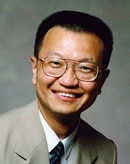Researchers at Florida State University are working to produce a commercially useful version of a material they have dubbed “buckypaper.” According to the research team at the Tallahassee-based institution, this material is 10 times lighter than steel but 250 times stronger. It is both thermally and electrically conductive and could be used as a film to protect electronic circuits and devices within airplanes from damaging EMI. Similarly, it could be used to shield the electronic “signature” of military aircraft that can be detected by radar. Apart from its military applications, charged buckypaper could be used to produce more uniform brightness in the television and computer screens of the future.Developed at the university’s Florida Advanced Center for Composite Technologies (FAC2T) headed by Dr. Ben Wang (at left), buckypaper is made from carbon nanotubes —amazingly strong fibers about 1/500,000th the diameter of a human hair. It owes its name to buckminsterfullerene, or Carbon 60, a type of carbon molecule with powerful atomic bonds that make it twice as hard as a diamond. Carbon 60 is often referred to as “buckyballs” because of the molecules’ spherical shape. At present buckypaper is produced only in the laboratory, but officials at FSU are in the process of forming a company that would use this new development in materials science in commercial applications. Find more information in the FSU press release.You don’t have to wait until buckypaper becomes available to find answers on your shielding questions. Just go to the Interference Technology Shielding Forum.
Florida Researchers’ “Buckypaper” Could Revolutionize EMC and Other Areas of Engineering
